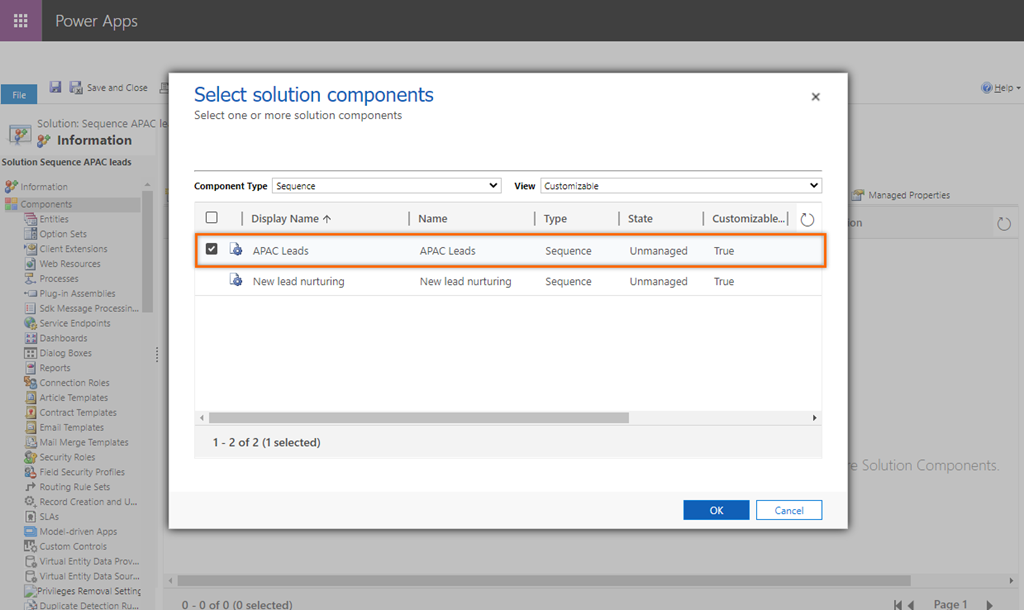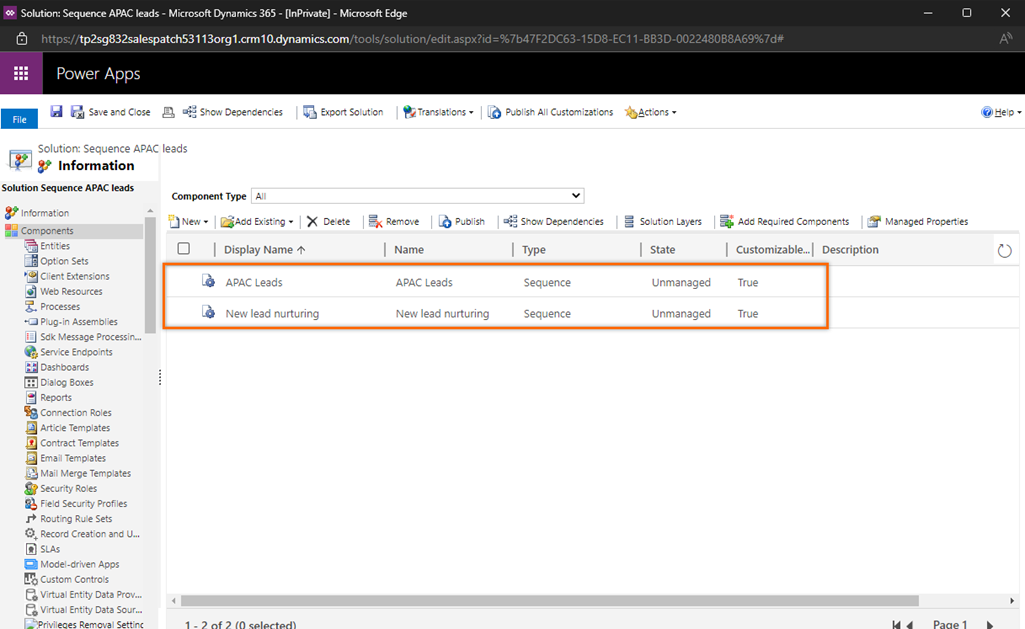Migrate sequences from one environment to another
Use the solution export and import functionality to migrate sequences from one environment to another in Dynamics 365 Sales.
License and role requirements
| Requirement type | You must have |
|---|---|
| License | Dynamics 365 Sales Premium or Dynamics 365 Sales Enterprise More information: Dynamics 365 Sales pricing |
| Security roles | System Administrator or Sequence Manager More information: Predefined security roles for Sales |
Migrate sequences
Organizations use staging (non-production) environments to set up and test complex steps, such as sequences, assignment rules, and segments. Organizations then use the staging environments to test these steps to avoid any disruption in their operations, saving time and money. Also, the staging environments help in training the sellers.
Administrators and sales managers can now migrate sequences along with their dependent entities from one environment to the other. To migrate sequences, complete the following steps:
Create a solution
Let’s create a sequence solution with an example.
Sign in to the Sales Hub app and go to Settings > Advanced Settings.
On the Advanced settings page, go to Setting > Customization > Solutions.
On the Solutions page, select New and then on the New solution dialog, enter the values for the following fields:
Column Description Display name Specify a meaningful name. Display name appears in the list of solutions and can be changed later. Example: Sequence APAC leads Name Specify a unique name for the solution. This field is populated using the value you enter in the Display name field. You can edit this before you save the solution, but not after. Publisher Select the default publisher or create a new publisher. We recommend that you create a publisher for your organization to use consistently across your environments where you'll use the solution. Example: CDS Default Publisher. Version Specify a version number for the solution. This version number will be included in the file name when you export the solution. 
Select Save and close.
The solution is created and listed under solutions.

Now, let’s add the required sequences into the solution.
Add sequence to the solution
After you create the solution, add the sequences that you want to export through the solution.
Open the solution. In this example, we’re opening the Sequence APAC leads solution.

Select Add existing > Sequence.
The Add existing sequence page opens with a list of sequences.
Select and add the sequences that you want to include in this solution. In this example, we’re selecting and adding APAC Leads.

The sequence and its dependent components such as sequences, email templates, business process flows (BPF) record, sequence tags, and attributes are added to the solution.
In our example, the New lead nurturing sequence is added to the list because the APAC Leads sequence contains it as a step.

To see other dependent entities of the added sequences, select the sequence, and then select Show Dependencies and go to the Required components section. In this example, we are viewing the other dependencies of APAC Leads sequence.
Note
If the sequence contains managed components, they won't be added to the solution. Therefore, when the solution is imported, the steps that are dependent on the missed components will show an error. To resolve the errors in the target organization, go to Troubleshoot solution import errors in Microsoft Dynamics 365.

Now that you've added the sequences, export the solution.
Export the solution
Always export the sequence as an unmanaged solution. The unmanaged dependent components of the sequences are automatically added to the solution package; managed components aren't added. When the solution is imported, the steps that depend on the missing components will show an error. To resolve the error, install the dependent components in the target environment. More information: Solution install fails due to missing dependencies.
Also, you can edit the sequences and their dependent components in the target environment after the import.
On the Solutions page, select the solution. In this example, let’s select Sequence APAC leads.
From the tool bar, select Export.

On the Publish Customizations dialog, select Next.
Note
After you’ve added the sequence and its dependent components to the solution and if you’ve made any changes that you would like to export, select Publish All Customizations. The updates are added to the solution.
On the Export System Settings (Advanced) dialog, select the required system settings and then select Next.
On the Package Type dialog, select Unmanaged and then select Export.
More information: Managed and unmanaged solutions |

The export can take several minutes to complete. Once finished, the exported .zip file is available in the download folder specified by your web browser. Download the zip file to your local computer. For example, SequenceAPACleads_1_0_0_1.zip.
Now, the solution is ready for import.
Import the solution
Sign in to the Sales Hub app and go to Settings > Advanced Settings.
On the Advanced settings page, go to Setting > Customization > Solutions and select Import.

On the Select Solution Package dialog, select Choose File and open the solution that you've downloaded.

Select Next.
On the Solution Information dialog, select Import.
Note
To view the details of the imported solution, select View solution package details.

The solution is imported into the target environment along with its dependent components. Also, when you delete the sequence, the dependent components remain in the imported environment, in case the components are used by other sequences or entities.
Note
If the import fails due to missing dependencies, a message is displayed on the top of the dialog. To troubleshoot import-related issues for solutions, go to Troubleshoot solution import errors in Microsoft Dynamics 365.
On the Importing Solution dialog, select Close.
Can't find the options in your app?
There are three possibilities:
- You don't have the necessary license or role.
- Your administrator hasn't turned on the feature.
- Your organization is using a custom app. Check with your administrator for exact steps. The steps described in this article are specific to the out-of-the-box Sales Hub and Sales Professional apps.
See also
Feedback
Coming soon: Throughout 2024 we will be phasing out GitHub Issues as the feedback mechanism for content and replacing it with a new feedback system. For more information see: https://aka.ms/ContentUserFeedback.
Submit and view feedback for